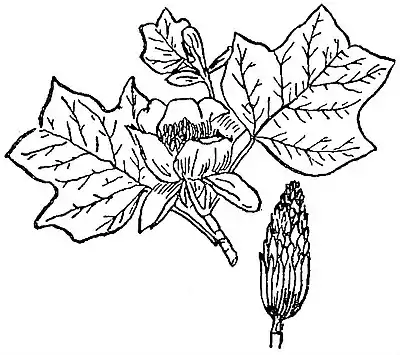TULIP TREE, the Liriodendron tulipifera, one of the most magnificent forest trees of temperate North America; attaining in favorable situations a height of 100-190 feet, with a straight, clear trunk. It is the only species of the genus—which belongs to the Magnolia family—and may be recognized by its large three-lobed leaves, with the middle lobe cut square at the end, and large solitary tulip-like flowers having greenish sepals, and petals variegated with yellow and orange. The wood is highly esteemed, uniting lightness with strength and durability. It is of a pale-yellow color, fine-grained, compact, is easily worked, takes a good polish, and is therefore much used by house and bridge constructors, by cabinet-makers, coach-builders, implement-makers, etc., and by the Indians for canoes. The bark is officinal in the secondary list of the “United States Pharmacopœia” as a stimulant, tonic, and diaphoretic. The noble appearance of the tree led to its introduction over 200 years ago into Europe, where it is appreciated as a great ornament for pleasure grounds, etc. It is found from Vermont to Michigan and S. to Florida and Mississippi.

TULIP TREE